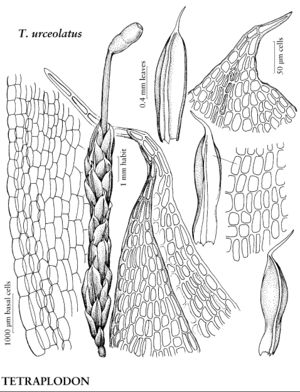Tetraplodon urceolatus
Bryol. Europ. 3: 217. 1844.
Plants 1–4 cm, yellow-green distally. Leaves ovate, very concave, 1.5 × 0.8 mm; margins entire; apex broadly acute; costa ending before subula; distal laminal cells rectangular, 25–30 × 15–18 µm. Sexual condition autoicous or dioicous. Seta stramineous, dark red with age, 0.3–0.7 cm. Capsule not cleistocarpous, dark reddish, cylindric, somewhat oblong; hypophysis as wide as or wider than urn; stomata over whole of hypophysis; operculum hemispheric. Calyptra cucullate. Spores 10–11 µm, smooth or slightly papillose.
Phenology: Capsules mature late summer.
Habitat: Dung of carnivores, old bones, owl pellets in dry, very exposed places, open tundra, mountain summits
Elevation: low to high elevations
Distribution

Greenland, Alta., B.C., Man., N.W.T., Nunavut, Que., Yukon, Alaska, c Europe, e, s Asia
Discussion
Tetraplodon urceolatus is an arctic or alpine moss very similar to reduced northern forms of T. mnioides; however, T. urceolatus has short yellowish setae, small strongly concave appressed leaves, and a short hypophysis about as long as the urn, sometimes lighter, and the same color or darker than the urn with age, and with relatively fewer stomata generally confined to the distal portion of the hypophysis. In general, T. urceolatus has firm leaves with stiff, rounded apices and thick distal cell walls. The exostome teeth of T. urceolatus are reflexed, orange-red at the apices, and inserted below the capsule mouth.
Selected References
None.
